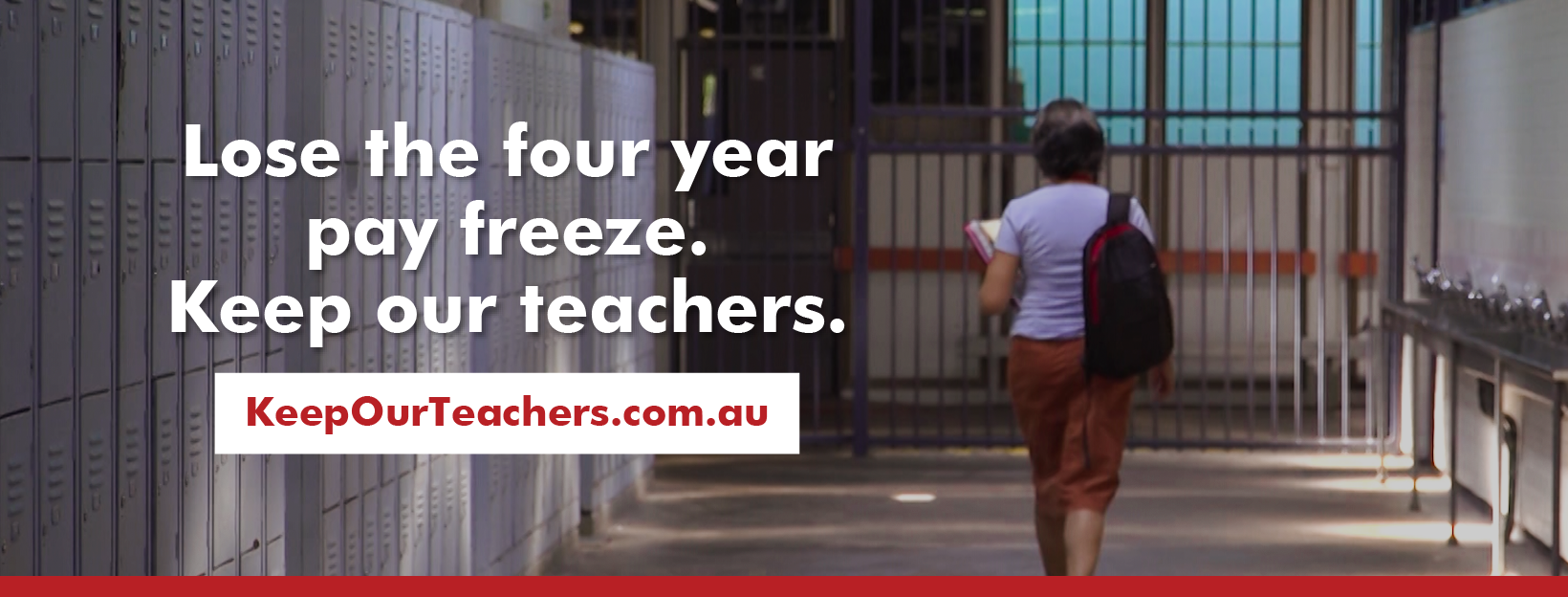On 3 November, the Commissioner for Public Employment wrote to the AEU NT with a formal offer for a new enterprise agreement covering NTPS teaching staff: CTs, STs, ATs and non-contract principals. We have been asked to provide feedback by Wednesday 17 November. Negotiations continue during this period, with revisions to the draft agreement still possible.
The union will make a formal recommendation to members on how to vote following the consultation period and a decision by Branch Executive on Friday 19 November.
A legally mandated access period from will occur from 22-28 November in which all employees will be able to read the draft agreement.
An electronic employee ballot conducted on behalf of the employer by the NT Electoral Commission will be held from Monday 29 November until Monday 6 December. All employees covered by the agreement will be eligible to vote.
The advice provided here is not intended to be an exhaustive guide to all elements of the Commissioner’s offer. We have highlighted what the bargaining team believes are the most important elements. The bargaining team welcomes member feedback on any elements of the Government’s offer.
1. THE GOOD
Improved commitments to secure employment
The proposed agreement will introduce language stating that the preferred mode of employment is ongoing (permanent) and commit to working in good faith to develop strategies to reduce the numbers and proportions of staff employed on fixed period contracts. In parallel to the bargaining process, the union is participating in a departmental working group to develop a new framework for appointing teachers to permanent positions to replace (or at least supplement) the current “permanency project”.
Part-time employment
A clause codifying part-time employment arrangements will be introduced for the first-time, giving employees greater rights to apply for part-time employment and to shift between full-time and part-time work. Staff returning from parental leave will now have a guaranteed right to part-time work for at least the first six months (currently, there is a right to request).
Probation
In line with commitments for greater opportunities for permanency, probation will apply only to ongoing teachers, not teachers on contract. Early career teachers will still be obligated to demonstrate proficiency sufficient to ensure their progress from provisional to full registration with the TRB.
Non-contract principals
We successfully negotiated coverage of non-contract principals, whose pay and conditions are currently technically covered by a Commissioner’s Determination due to creation of a new principal classification structure in July this year. The Determination will co-exist with the new agreement, but changes will only occur with union consent.
Assistant teacher salary progression
Many ATs have been unable to progress through their increments due to difficulties in obtaining the necessary certification of qualifications from a tertiary or VET provider. The new framework would enable ATs to progress with CEO approval based on principal certification of their competency against the Department’s Professional Standards for Assistant Teachers.
Relief teachers
The clause covering relief teachers will be amended to make it clear that relief staff are casual NTPS employees, not school representative body workers.
Study leave
The clause on study leave will be amended to enable employees to submit their application in advance for study leave in the final semester before they accrue the necessary points, rather than having to wait until the points are accrued before applying. This will mean a category 3 teacher, for example, will be eligible for study leave after 4 years instead of having an additional semester. This is a win that restores what was the process until the department changed its approval process several years.
Business days
The existing policy will be reviewed to ensure it is consistent with the agreement. From the union’s perspective, greater flexibility should be granted in ensuring employees are able to make use of their business days, irrespective of whether they are leaving the community, as many services can now be accessed virtually.
Improved common core provisions
The Commissioner has proposed a number of improvements for all public sector employees that would make this agreement more family friendly and flexible. These include expansion of compassionate leave, access to purchased leave, paid kinship obligation leave, paid foster and kinship carer’s leave, health screening, gender transition leave, and some improvements to superannuation arrangements for employees accessing parental leave.
2. THE (POTENTIALLY) PROBLEMATIC
Electricity subsidy
Most teaching employees in government-employee housing (GEH) do not currently pay for their electricity. In some localities, such as Nhulunbuy and Jabiru, employees pay their full utility bill and receive no subsidy. In Borroloola, employees pay for their electricity but receive an allowance specified by the Commissioner which is based on category of remoteness and adjusted each year based on Darwin inflation statistics (CPI). No other members covered by our EA are eligible for this subsidy.
The employer is proposing that all teaching employees in GEH be required to pay for their own electricity, but that they receive a subsidy to offset those costs. Based on current rates, the subsidy would be as follows:
Proposed remote employee electricity subsidy (per annum rate, $)
| Special Category | Category 1 | Category 2 | Category 3 | |
| No Dependants | 700 | 1399 | 2100 | 2801 |
| Dependant rate | 875 | 1751 | 2626 | 3502 |
The subsidy would be paid fortnightly and effectively become part of an employee’s salary, like the Remote Incentive Allowance, meaning it would count towards superannuation, but would also be subject to taxation. Depending on your annual electricity costs and current arrangements, you could be better off than you are currently, however in some circumstances you could be out of pocket. Our concern is that members in Category 2 and 3 localities, who typically do not pay for electricity currently, could end up financially worse off than they are currently due to the introduction of the subsidy.
Stand down
This is a technical issue, but an important one. Please read carefully as we attempt to explain this proposal in the simplest terms possible.
Stand down is a long-standing administrative arrangement largely governed by custom and practice that means employees are paid during school holiday periods during which they are not required to attend work but are not deemed to be on annual recreation leave. It solves the issue of public servants accruing only six weeks of recreation leave per year but schools being closed to students for 12 weeks per annum.
Technically, employees are usually deemed to be on rec leave over the Christmas holiday period and for the first three days of the Term 1 holidays each year, with the remainder of school holiday periods treated as stand down. Currently, whether an employee is paid during stand down, or deemed to be on leave, can be affected by factors such as whether an employee is on unpaid leave immediately adjacent to a stand down period.
The benefit of the proposed change is that would codify stand down in the agreement for the first time and specify an employee’s entitlement as well as how stand down interacts with various forms of leave. However, it would also effectively turn stand down into a secondary form of accrued annual leave, in which payment during non-term time would be conditional on the number of days worked in the previous term.
Most employees would not be affected by the change. However, once an employee is on unpaid leave for more than 30% of the school term, their subsequent stand down payment would begin to be reduced. They would be paid pro rata for time worked, despite already being penalised in loss of pay and accrual of leave, and unable to make up the time by working during the stand down period.
Mid-career teacher progression
A new clause would enable the CEO to authorise newly employed teachers to be engaged at a higher CT level based on recognition of prior, relevant experience in a non-teaching role. The intent is to attract teachers with expertise in areas like maths who may have relevant industry experience, for example. At this stage there is no detail of the assessment criteria or how widely this measure is intended to be used.
Workloads and wellbeing
The draft agreement included a reference to the Department’s Teacher Wellbeing Strategy, which does include a project to address teacher workload, but beyond that the employer has not agreed to any of the union’s claims to address workload, such as smaller class sizes.
Katherine housing
Our claim to create certainty for members in Katherine about their housing subsidy is unresolved, pending the outcome of a review commissioned by DoE.
Highly Accomplished and Lead Teachers
Certified Highly Accomplished and Lead Teachers will continue to be eligible to receive an allowance, however the employer is proposing to insert language requiring HALTs to have a professional growth plan in place to be eligible. This is a requirement for all employees, and HALTs are typically performing at a much higher level than the average classroom teacher or they would not have been able to obtain the certification, so it should only be a formality, however we are requesting feedback from HALT members on this proposal.
Professional development days
The Department proposes fixing PD days to occur at the beginning of each term, rather than allowing two to be flexible. Schools could divert from this pattern with CE approval. The bargaining team has no in-principle objection, however we are requesting member feedback on this proposal.
3. THE BAD
Four-year pay freeze
The offer confirms what everyone knew was coming. The only additional remuneration to employees would be a $1000 payment per annum, not indexed to salaries.
Increases to salaries and superannuation not funded
The Government has not made additional funding available to agencies to cover the $1000 annual payments, nor the required increases in the superannuation guarantee. Our estimate is the combined annual cost of these commitments is about $7 million. Paying for even these meagre benefits will come at the expense of schools’ existing budgets. In larger schools it may mean the loss of teachers.
Length of agreement
Although we have no in-principle objection to a four-year agreement, it is unacceptable in the context of the pay freeze. The Commissioner commits to passing on additional remuneration to employees if the Government increases its Wages Policy over the four years. If there is a possibility the Wages Policy may change, the offer should be for a short agreement (one or two years), to enable further negotiations in 2022 or 2023.
Relief teachers guaranteed nothing
There is no guarantee relief teachers will get any remuneration at all. Despite the Commissioner’s office saying they will try to ensure relief teachers will get the $1000 payment, they will not guarantee this.
For media enquiries contact Branch President Jarvis Ryan or Secretary Adam Lampe on on (08) 8948 5399.
Resources
Download this information in PDF format
Download the Commissioner’s offer in PDF format


